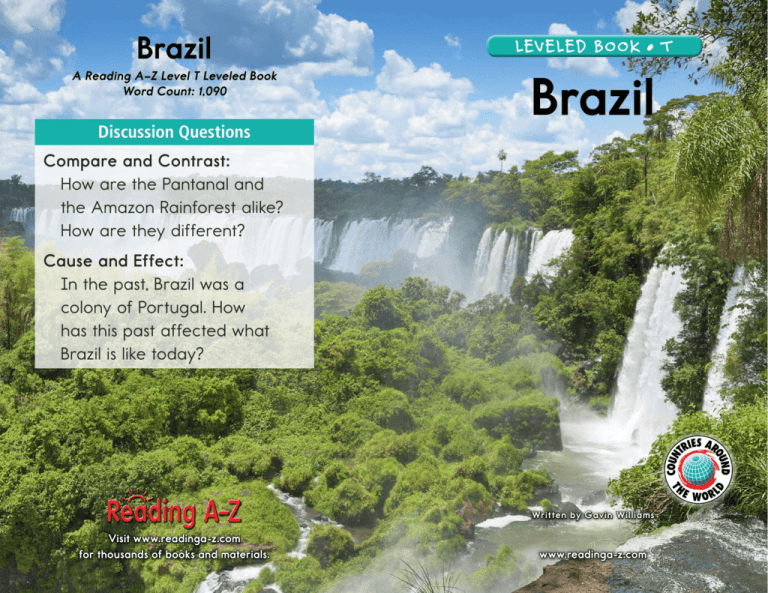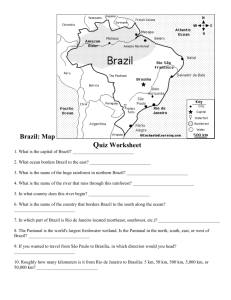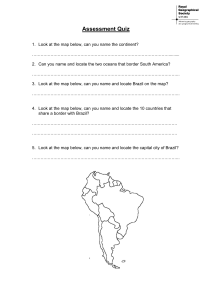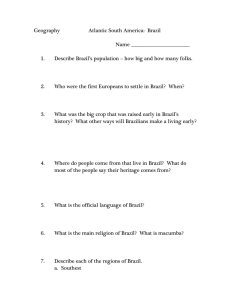
Brazil
A Reading A–Z Level T Leveled Book
Word Count: 1,090
Discussion Questions
LEVELED BOOK • T
Brazil
Compare and Contrast:
How are the Pantanal and
the Amazon Rainforest alike?
How are they different?
Cause and Effect:
In the past, Brazil was a
colony of Portugal. How
has this past affected what
Brazil is like today?
Written by Gavin Williams
Visit www.readinga-z.com
for thousands of books and materials.
www.readinga-z.com
Glossary
cassava (n.)a plant with thick roots that
grows in the tropics and is used
in cooking (p. 6)
Brazil
Catholic (adj.)of or having to do with the
Roman Catholic Church, a
branch of Christianity (p. 11)
dictators (n.)leaders who rule with total
power, usually by force (p. 10)
highlands (n.)areas with many mountains;
land that is high above sea
level (p. 8)
Pantanal (n.)wetlands in south central Brazil
that extend into Paraguay and
Bolivia (p. 9)
plantations (n.)large farms with many workers
(p. 6)
plateaus (n.)large raised areas of flat land
(p. 8)
sugarcane (n.)a tropical grass that sugar comes
from (p. 10)
tributaries (n.)rivers or streams that flow into
larger rivers (p. 9)
Written by Gavin Williams
www.readinga-z.com
16
Brazil
Photo Credits:
Front cover, back cover: © vau902/iStock/Thinkstock; title page: © Ken Klotz/
iStock/Thinkstock; page 3: © Peter M. Wilson/Alamy; page 5: © Phototreat/
iStock/Thinkstock; page 6: © Marina Lohrbach/Dreamstime.com; page 7:
© AP Images; page 8: © Johnny Lye/iStock/Thinkstock; page 11: © Yadid Levy/
Alamy; page 12 (top left): © nicholashan/iStock/Thinkstock; page 12 (right):
© jimodenney/iStock/Thinkstock; page 12 (bottom left): © Ricardo Bazarin/
Dreamstime.com; page 13 (left): © Anthony Hathaway/Dreamstime.com; page
13 (right): © Eric Gevaert/Dreamstime.com; page 14: © Elder Salles/Dreamstime.
com; page 15 (main): © Vinicius Tupinamba/Hemera/Thinkstock; page 15 (inset):
© Renan gustavo Kunst/Hemera/Thinkstock
Front and back cover: Iguazu (EH-gwah-SOO) Falls is a series of waterfalls
between Brazil and Argentina.
Title page: Beautiful hyacinth macaws live in Brazil. They are in danger of
disappearing from the Earth due to habitat loss.
Page 3: People wear colorful costumes and dance in parades during Carnaval,
a holiday in Brazil.
Population: 202,656,788
Land: 8,458,417 sq km (3,265,813 sq. mi.)
Capital City: Brasília
Primary Language: Portuguese
Primary Religion: Catholic
Currency: Real (ray-AHL)
Brazil
Countries Around the World
Level T Leveled Book
© Learning A–Z
Written by Gavin Williams
All rights reserved.
www.readinga-z.com
Correlation
LEVEL T
Fountas & Pinnell
Reading Recovery
DRA
P
38
38
Source: Central Intelligence Agency (July 2014), World Bank
Brazil • Level T
15
Table of Contents
The large city of Rio de Janeiro is also known for its many beautiful beaches.
Where Is It? ��������������������������������������������������������� 4
Conclusion
People ����������������������������������������������������������������� 6
Brazil is a country filled with life. The
Amazon rainforest teems with more living
things than anywhere else on Earth. The
people in the cities and countryside have
vibrant celebrations unlike any other.
From its land to its animals and people, the
vast country of Brazil has many things to learn
about and explore.
14
Land ������������������������������������������������������������������� 8
History ������������������������������������������������������������� 10
Celebrations ����������������������������������������������������� 11
Animals ����������������������������������������������������������� 12
Conclusion ������������������������������������������������������� 14
Glossary ����������������������������������������������������������� 16
Brazil • Level T
3
Brazil
Guyana
Venezuela
Colombia
Suriname
French Guiana
ATLANTIC
OCEAN
São Luis
Brazil
Peru
Brasília
giant anteater
golden lion tamarin
Bolivia
PACIFIC
OCEAN
Paraguay
NORTH
AMERICA
SOUTH
AMERICA
São Paulo
Rio de
Janeiro
Argentina
Uruguay
Where Is It?
Other parts of Brazil, such as the Pantanal
wetlands, also include unique animals. Storks
and herons build nests in the Pantanal’s trees.
Colorful parrots, such as the blue and yellow
macaw, fly overhead. Deer and jaguar roam
the land. Giant anteaters also live in the
Pantanal.
The western half of Brazil shares a border
with many smaller countries. These countries
include Venezuela, Colombia, Peru, Bolivia,
Paraguay, Argentina, and Uruguay.
Sadly, some animals in the Amazon
rainforest and the Pantanal could disappear
from Earth forever. Every year, trees are cut
down for timber and to clear land for farming.
As a result, animals like the jaguar and the
golden lion tamarin, a type of monkey, are
losing their habitat. Many organizations
are working together with the Brazilian
government to keep this from happening.
4
Brazil • Level T
Brazil is the largest country in South
America and covers nearly half of the entire
continent. It is almost as large as the entire
United States.
13
To the east of Brazil is the Atlantic Ocean.
The country’s coastline is more than 7,400
kilometers (4,600 mi.) long.
toucan
piranha
jaguar
Animals
Brazil is home to the widest variety of life
on Earth. The Amazon rainforest provides
a home to more animals­—and plants—than
any other environment in the world. Colorful
birds such as the toucan (TOO-kan) live there,
as well as jaguars and ocelots (OS-uh-lotz).
Slow-moving sloths hang from trees, and
giant anacondas slither along the forest floor.
Many different types of monkeys swing from
the trees.
In the Amazon River, meat-eating fish
called piranhas (pi-RAH-nuhz) hunt in groups
of one hundred or more. Large manatees swim
through the water.
12
The capital of Brazil is Brasília (bruh-ZILyuh), which is located near the middle of the
country. However, Brasília wasn’t always the
capital. The larger city of Rio de Janeiro (REEoh DAY zhuh-NAIR-oh), located on the east
coast of the country,
was the capital until
1960. The government
decided to build
a new capital city
farther inland.
Although it is
still new, Brasília
is growing quickly.
More than two
million people live
and work there.
Many people work
for the government,
Brasília is filled with many modern
since the city is
buildings.
Brazil’s political center.
Brazil • Level T
5
People
More than 200 million people live in Brazil,
and eight out of every ten people live in cities.
The country has several large cities, including
São Paulo (SOW POW-low), the largest city
in South America.
Many people in Brazil work in service
industries, such as construction, banking,
education, and healthcare. Large hotels and
restaurants line many of the country’s beaches,
providing work for people living along the
coast. Other Brazilians work in factories,
making cars, airplanes, and steel. Many of
these factories are located around São Paulo.
In the countryside, people work in mining
and farming. Brazil is a leading producer of
minerals such as iron ore, tin,
and even gold. Brazil’s farmers
grow much of the world’s coffee
on huge plantations. They also
grow oranges, cassava, and
soybeans. Some farmers raise
Brazil grows the most
hogs and chickens, and
popular type of
coffee, called Arabica.
ranchers raise cattle.
6
Rio de Janeiro has the largest Carnaval celebration in Brazil. It is held
in a special building called the Sambadrome.
Celebrations
Many holidays in Brazil are religious
in nature. Most Brazilians belong to the
Catholic faith, a religion that was brought
to Brazil by the Portuguese. However,
because Brazilians come from many
different backgrounds, religious customs
of other groups—such as American Indian
and African—are also followed.
Carnaval is the largest and most popular
holiday in Brazil. It is a four-day celebration
leading up to Lent, which is the forty-day
period in which Catholics prepare for Easter.
During Carnaval, people crowd into Brazil’s
streets for parades and dancing. Many people
wear elaborate costumes with masks and
headdresses.
Brazil • Level T
11
History
Futebol
The first known people who lived in Brazil
were American Indians. Different groups of
these people still live in the jungles and along
the banks of the Amazon River today.
In the early sixteenth century, Portugal
claimed Brazil. The Portuguese used the land
to collect a type of wood called pau brasil (POW
brah-SEEL), or brazilwood. This unique type
of wood is how the new colony got its name.
The Portuguese forced many of the American
Indians to work on huge sugarcane plantations.
Later, slaves were brought from Africa to work
on coffee plantations and in diamond and
gold mines.
In 1822, Brazil became an independent
country ruled by an emperor. Slavery ended
in 1888. In 1889, the emperor at the time was
forced by the military to step down, and Brazil
became a republic. In a republic, the people
usually choose their leaders, but this didn’t
always happen in Brazil. Instead, the people
were often led by dictators. After much
turmoil, the country became a democracy
in 1985.
10
Pelé
Many Brazilians enjoy
watching and playing
soccer, which they call
futebol (FOOT-bohl). Brazil
has won the World Cup,
the world’s largest soccer
tournament, more than
any other country. The
country’s most famous
soccer player—Pelé—is
known around the world.
Pelé led his team to victory
in the World Cup
in 1958, 1962, and in 1970.
Brazilians come from many different
backgrounds. Some are descended from the
native people who first lived there. Many
others are descended from people who came
to Brazil from far-away countries such as
Portugal, Spain, Germany, and other places
in Europe. In fact, Brazil was a colony of
Portugal for three hundred years, and the
main language in Brazil is Portuguese (PORchuh-geez). Many other people are descended
from slaves brought to the country from Africa
to work on plantations and in mines.
Brazil • Level T
7
Brazil’s Landforms
Land
Brazil is so large that it includes five main
regions. The landforms in each region are so
different that they are like separate countries.
The north and southeast regions include
highlands. In the north, the Guiana Highlands
consist of steep mountains and deep valleys.
In the southeast, hills and low mountain
plateaus make up the Brazilian Highlands.
8
Guiana Highla
nds
nR
azo
m
A
iver
Pantanal
Wetlands
PACIFIC
OCEAN
zilia
nH
Brasília
ighl
an d
s
Amazon
Basin
ATLANTIC
OCEAN
Bra
Many rivers flow through
Brazil, making the soil rich
and good for growing crops.
However, one river clearly
stands out. The Amazon
River is one of the widest and
longest rivers in the world,
flowing for at least 6,400
kilometers (4,000 mi.) through The Amazon River
carries more water
northern Brazil. Its waters
than any other river
on Earth.
feed the vast Amazon basin,
which covers nearly half of Brazil and about
7 million square kilometers (3 million sq. mi.).
The largest tropical rainforest in the world,
the Amazon rainforest, is also located here.
Coastal
Lowlands
Brazil’s long east coast makes up another
region. It includes beautiful sandy beaches,
which are some of the main attractions for
tourists visiting the country.
The Pantanal is located in central Brazil.
It is one of the world’s largest freshwater
wetlands and extends for thousands of
miles around the tributaries of several
different rivers.
Brazil • Level T
9






